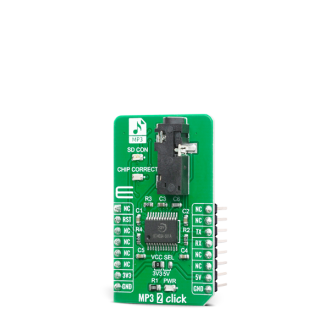
We strongly encourage users to use Package manager for sharing their code on Libstock website, because it boosts your efficiency and leaves the end user with no room for error. [more info]

Rating:
Author: MIKROE
Last Updated: 2020-07-03
Package Version: 1.0.0.0
mikroSDK Library: 1.0.0.0
Category: MP3
Downloaded: 3358 times
Not followed.
License: MIT license
The MP3 2 Click is a Click boardâ„¢ that features the KT403A, a compact audio IC, from Shenzhen Qianle Microelectronics Technology Co. Ltd. This Click board provides a various audio file operations for an audio multiple formats file (MP3 and WAV).
Do you want to subscribe in order to receive notifications regarding "MP3 2 click" changes.
Do you want to unsubscribe in order to stop receiving notifications regarding "MP3 2 click" changes.
Do you want to report abuse regarding "MP3 2 click".


Library Description
The library covers all the necessary functions to control MP3 2 Click board. A library performs the communication with the KT403A chip which integrate 16-bit MCU, and audio decoder, a DSP especial for decoding via UART interface.
Key functions:
void mp32_play_mode ( void ) - Play mode function.void mp32_play_next ( void ) - Play next function.void mp32_volume_up ( void ) - Volume up function.Examples description
The application is composed of three sections :
void application_task ( )
{
char received_data;
if ( UART_Rdy_Ptr() )
{
received_data = UART_Rd_Ptr( );
switch ( received_data )
{
case 'c' :
{
command_list( );
break;
}
case 'p' :
{
mp32_play_mode( );
mikrobus_logWrite( " >>> Play", _LOG_LINE );
break;
}
case 'o' :
{
mp32_pause_mode( );
mikrobus_logWrite( " >>> Pause", _LOG_LINE );
break;
}
case 's' :
{
mp32_stop_mode( );
mikrobus_logWrite( " >>> Stop", _LOG_LINE );
break;
}
case 'n' :
{
mp32_play_next( );
mikrobus_logWrite( " >>> Play next", _LOG_LINE );
break;
}
case 'l' :
{
mp32_play_previous( );
mikrobus_logWrite( " >>> Play previous", _LOG_LINE );
break;
}
case '+' :
{
mp32_volume_up( );
mikrobus_logWrite( " >>> Volume Up", _LOG_LINE );
break;
}
case '-' :
{
mp32_volume_down( );
mikrobus_logWrite( " >>> Volume Down", _LOG_LINE );
break;
}
default :
{
command_list( );
break;
}
}
}
Delay_ms( 1000 );
}
Key functions:
command_list( ) - Display the list of commands.Other mikroE Libraries used in the example:
Additional notes and informations
Depending on the development board you are using, you may need USB UART click, USB UART 2 click or RS232 click to connect to your PC, for development systems with no UART to USB interface available on the board. The terminal available in all MikroElektronika compilers, or any other terminal application of your choice, can be used to read the message.